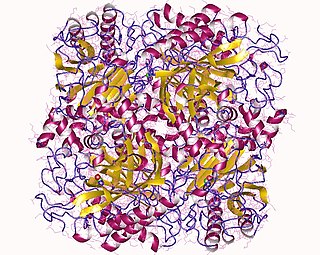In organic chemistry, a nitrile is any organic compound that has a −C≡N functional group. The prefix cyano- is used interchangeably with the term nitrile in industrial literature. Nitriles are found in many useful compounds, including methyl cyanoacrylate, used in super glue, and nitrile rubber, a nitrile-containing polymer used in latex-free laboratory and medical gloves. Nitrile rubber is also widely used as automotive and other seals since it is resistant to fuels and oils. Organic compounds containing multiple nitrile groups are known as cyanocarbons.

Glutamate dehydrogenase is an enzyme observed in both prokaryotes and eukaryotic mitochondria. The aforementioned reaction also yields ammonia, which in eukaryotes is canonically processed as a substrate in the urea cycle. Typically, the α-ketoglutarate to glutamate reaction does not occur in mammals, as glutamate dehydrogenase equilibrium favours the production of ammonia and α-ketoglutarate. Glutamate dehydrogenase also has a very low affinity for ammonia, and therefore toxic levels of ammonia would have to be present in the body for the reverse reaction to proceed. However, in brain, the NAD+/NADH ratio in brain mitochondria encourages oxidative deamination. In bacteria, the ammonia is assimilated to amino acids via glutamate and aminotransferases. In plants, the enzyme can work in either direction depending on environment and stress. Transgenic plants expressing microbial GLDHs are improved in tolerance to herbicide, water deficit, and pathogen infections. They are more nutritionally valuable.
In enzymology, a carboxylate reductase (EC 1.2.99.6) is an enzyme that catalyzes the chemical reaction
In enzymology, a glycine dehydrogenase (EC 1.4.1.10) is an enzyme that catalyzes the chemical reaction
In enzymology, a L-glutamate oxidase (EC 1.4.3.11) is an enzyme that catalyzes the chemical reaction
In enzymology, a 1-aminocyclopropane-1-carboxylate deaminase (EC 3.5.99.7) is an enzyme that catalyzes the chemical reaction
In enzymology, an aliphatic nitrilase also known as aliphatic nitrile aminohydrolase (EC 3.5.5.7) is an enzyme that catalyzes the hydrolysis of nitriles to carboxylic acids:
In enzymology, a beta-ureidopropionase (EC 3.5.1.6) is an enzyme that catalyzes the chemical reaction
In enzymology, a carnitinamidase (EC 3.5.1.73) is an enzyme that catalyzes the chemical reaction
In enzymology, a cyanoalanine nitrilase (EC 3.5.5.4) is an enzyme that catalyzes the chemical reaction

In enzymology, a formamidase (EC 3.5.1.49) is an enzyme that catalyzes the chemical reaction
In enzymology, a mandelamide amidase (EC 3.5.1.86) is an enzyme that catalyzes the chemical reaction
In enzymology, a N-carbamoylputrescine amidase (EC 3.5.1.53) is an enzyme that catalyzes the chemical reaction
In enzymology, a N-carbamoylsarcosine amidase (EC 3.5.1.59) is an enzyme that catalyzes the chemical reaction

In enzymology, a nicotinamidase (EC 3.5.1.19) is an enzyme that catalyzes the chemical reaction
In enzymology, a nicotinamide-nucleotide amidase (EC 3.5.1.42) is an enzyme that catalyzes the chemical reaction

In enzymology, an omega-amidase (EC 3.5.1.3) is an enzyme that catalyzes the chemical reaction
In enzymology, a pentanamidase (EC 3.5.1.50) is an enzyme that catalyzes the chemical reaction
L-proline amide hydrolase (EC 3.5.1.101, S-stereoselective piperazine-2-tert-butylcarboxamide hydrolase, LaaA, L-amino acid amidase) is an enzyme with systematic name (S)-piperidine-2-carboxamide amidohydrolase. This enzyme catalyses the following chemical reaction

Chlorophyllide a and Chlorophyllide b are the biosynthetic precursors of chlorophyll a and chlorophyll b respectively. Their propionic acid groups are converted to phytyl esters by the enzyme chlorophyll synthase in the final step of the pathway. Thus the main interest in these chemical compounds has been in the study of chlorophyll biosynthesis in plants, algae and cyanobacteria. Chlorophyllide a is also an intermediate in the biosynthesis of bacteriochlorophylls.





